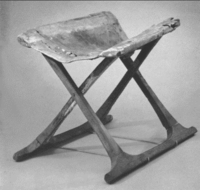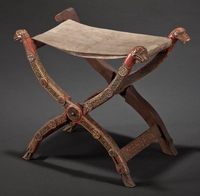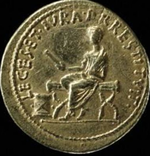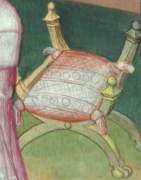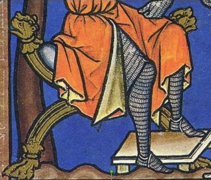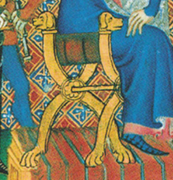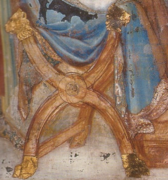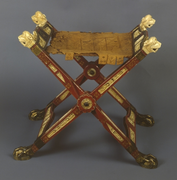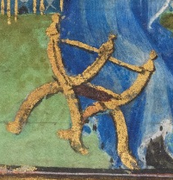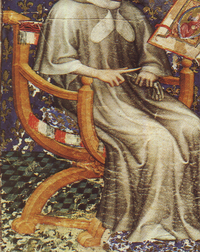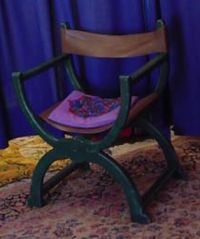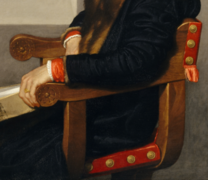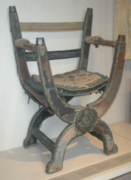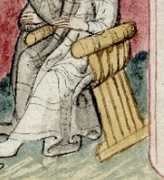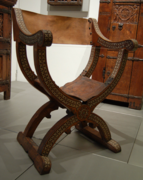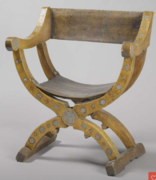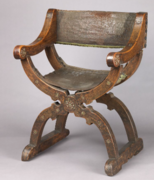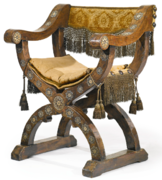Type 1
The Type 1 chair is the X frame chair (or stool). These seats use two connected X frames as the structure and they appear in two forms:
Their method of construction and materials are very similar. Beyond using a pair of connected X frames for the structure, they also share the feature of a flexible seat (and back where there is one). The seat and back can be either leather or textiles and if there is a back, it seems to be made of the same material as the seat.
Type 1A - The Folding Stool
Background:
Type 1A is a simple folding stool. Its structure is two X shaped frames that pivot on the crossover point and are connected by horizontal members. The seat is usually non-rigid and made of textiles or leather.
This form is first recorded in the Middle Kingdom of Egypt (2000-1500 BCE) both as art and extant examples from tomb finds. Based on what's known of early Egyptian culture, they got by with a very limited amount of furniture and were comfortable sitting on the ground in most cases. Therefore, having a seat of any type is a big deal and a clear status symbol even for something as simple as the one depicted to the right. It is only 14" high (modern chairs are 19").
At the left, we have a carved and painted medieval example from the Salzburg, Austria area. Made of pearwood and leather, the seat is about 20” high (the height of modern chairs).
Seating:
Both across and along the X.
In ancient times, this form was sat across the X. I've seen conjectures that the reason for this was that the X was a symbol for divinity or power, but I have seen no credible evidence for that assertion.
That said, coins from the Roman Republic show X frame stools sat crosswise, though coins from the Empire, show chairs with a back sat in the expected fashion. Following the civil wars and the rise of the Empire, there was certainly no longer any pretense of divine descent by the Emperors so it's possible that theory has some merit.
In the Middle Ages and later, this form is sat along the X as we’ve come to expect.
Practical Matters:
I haven't personally made any stools of this form, only its more complex descendant (see below), but I would rate it "good" on the folding scale for convenient packing/transit since it would pivot until the tops touch. It is particularly suited to camping or field use where a full-size chair isn't necessary.
Common Terms: Fold stool, Faltstuhl (German), Sella Curulis (Latin), Faldistorium (Latin)
Gallery of Period Illustrations and Extant Examples
Type 1B - The X Frame Chair
Background:
There was a lot of variation throughout the ages for the X frame seats. The most significant is the addition of a back. The material of the back is usually the same as the seat: textile or leather.
The adding of a back is accomplished by lengthening the top parts of the X frames. The front X is lengthened to a height to serve as armrests. The back X goes even higher to provide a place to anchor the back. An additional rail is added on each side to support the back and become armrests. The earliest evidence of a backed X chair that I have found (so far) is this 1371 painting shown to the right.
Seating:
Seating is along the X.
Practical Matters:
These chairs are pretty simple and easy to reproduce so they are a common sight in the SCA. What they don't do is fold much. The mechanism will rotate only until the top of the back supports touch each other. So, the taller and more comfortable you make the back, the less useful in folding it becomes. As a result, many historical examples go no higher than the center of the back.
Construction Notes:
It has been quite some time since I built these so I am trying to reconstruct the process. Don't look too unkindly on these chairs. It was the early days and I had limited tools and skills. With my squire Xenophon's help, we built 2 pairs of these chairs, one for me and one for him and his lady. Looking back, that was quite an ambitious undertaking given my skill set at the time. But they actually came together quite well and served us for many years.
The plans for these chairs were based on those published by Master Charles Oakley for a Coffer Chair. That link seems to be where the plans live now. You'll note the kind of photocopy of a photocopy motif, that's original, at least to the web version. Probably this was published locally in the Midrealm at a higher fidelity, but this what we used.
Since I was making 4 (without first making a prototype - not a recommended practice but I didn't know that at the time), I started by creating a full-scale template of the leg. I would need 16 of these, 4 per chair. While uniformity between chairs wasn't super important, the 4 that make up any one chair should be really similar.
The next hurdle was the wood selection. Oakley used 2" x 12" pine construction lumber. Perhaps where he lives that's high-quality timber. For instance, Southern Yellow Pine would be a good choice, but that species isn't common in Central Maryland. The fir we do get is hit and miss in terms of the grain quality we are looking for in this project.
Orienting the grain of the boards used for the Xs is critical because somewhere along the arc you can have a short-grain area that will be prone to breakage. Look at the illustration to the right. This is of an 18th Century Candle Stand, but the issue is the same.
The surviving pieces, as well as images from period works, all seem to be made from quite heavy timber by today's standards. That is one way to avoid this problem, but we were looking for portability. Oakley used 2x pine lumber (1¾" thick). I didn't like our pine options. I could in no way afford 4S4 hardwood like oak or maple and didn't have the ability to mill up rough lumber which would have been a lot cheaper.
Instead, I came up with the idea of laminating two sheets of maple plywood. This solves the grain direction problem, plywood is made up of alternating layers, so there is no weak direction. It would yield a chunk of wood 1½" thick, perfectly flat, and 4' x 8'. I could then lay out the parts neatly and cut them out with a band saw which I did have.
The result was strong enough to support my weight and yet light enough to be easily carried. Even carefully painted, it was hard to hide the plywood nature, but that was the best solution I had at the time.
These days I would laminate 2 pieces of 1" thick actual hardwood oriented to avoid weak grain areas. But I have ready access to rough lumber, a planer, a jointer, and an even better band saw. With modern glues, this would be way stronger than the plywood version and probably even the thick period ones.
The only tricky part of this build is the half-lap joint where the Xs cross. You just have to be careful and make sure both the front and back are exactly the same so you don’t add racking stress to the frame.
Common Terms: Dantesca Chair, X Chair, Dante Chair, Sedia Dantesca (Latin), Scherenstuhl (German)
Gallery of Period Illustrations and Extant Examples
If you'd like to continue this fascinating exploration of medieval folding seats,
